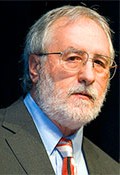-
(b.) - ?1949
Bio/Description
An American computer scientist, he is known for his work related to the Lisp programming language (and especially Common Lisp [CL]) in computing. His best known work was a 1990 essay, ?Lisp: Good News, Bad News, How to Win Big?, which incorporated the phrase Worse is Better, and his set of Lisp benchmarks (the "Gabriel Benchmarks"), published in 1985 as ?Performance and Evaluation of Lisp systems?, which became a standard way of benchmarking Lisp implementations. He was born in the town of Merrimac in northeastern Massachusetts to two dairy farmers. He was nearly accepted to Massachusetts Institute of Technology (MIT) and Harvard, but an argument with a teacher ended those prospects, and he ended up going to Northeastern University in Boston, Massachusetts, where he earned a B. A. degree in Mathematics (1967?1972). Subsequently, he pursued graduate studies in Mathematics at MIT, from 1972?73; he was tapped by Patrick Winston to become a permanent member of the AI Lab at MIT, but funding difficulties made it impossible to retain him. Along with Dave Waltz, he tried to start up an AI Lab at the University of Illinois, but after two years the lab fell through. In this time period he earned an M.S. degree in Mathematics (1973?1975). Because of some of his mathematical work, he was then admitted to Stanford University. During the period (1975?1981) he served as a Teacher's Assistant to John McCarthy, the founder of Lisp; he ported Maclisp from its native ITS to WAITS; and he earned a Ph.D. in Computer Science (1981) (on the topic of Natural Language Generation). In addition, he and his wife Kathy had a son. Around this time period, he also became a spokesperson for the League for Programming Freedom. After he earned his Ph.D., he continued to work on Artificial intelligence (AI) projects for McCarthy; although his thesis advisor was Terry Winograd. He eventually began working for Lawrence Livermore National Labs, where he recruited a number of the researchers and programmers for a company he founded in 1984, Lucid, Incorporated. Although the company survived until 1994, he left in 1992. He was, at various times the President and Chairman of Lucid Inc. The product the company shipped was an integrated Lisp integrated development environment (IDE) for Sun Microsystems? RISC hardware architecture. This sidestepped the principal failure of Lisp machines by, in essence, rewriting the Lisp machine IDE for use on a more cost-effective and less moribund architecture. During this time period, he married his second wife, and had a daughter; he later divorced his second wife in 1993. Eventually Lucid's focus shifted (during the AI Winter) to an IDE for C++. A core component of the IDE was Richard Stallman?s version of Emacs, GNU Emacs. GNU Emacs was not up to Lucid?s needs, however, and several Lucid programmers were assigned to help develop GNU Emacs. Friction arose between the programmers and Stallman over how to handle GUI issues, and Lucid forked; thus they were primarily responsible for the birth of what would come to be called XEmacs. One of his hires was another notable programmer, Jamie W. Zawinski. After he left Lucid, Inc. for good, he became a Vice President of Development for ParcPlace Systems (1994?1995), and then a consultant for, among others, Aspen Smallworks, before joining Sun Microsystems. As a Distinguished Engineer at Sun, he was an influential contributor to the evolution of the open source software strategy, culminating in publication of the book ?Innovation Happens Elsewhere?. In 2007, he joined IBM Research as a Distinguished Engineer. He is the recipient of the Association for Computing Machinery (ACM)'s 1998 Fellows Award and the 2004 Allen Newell Award. The citation reads: ?For innovations not only on fundamental issues in programming languages and software design but also on the interaction between computer science and other disciplines, notably architecture and poetry.? He was the conference chair of the 2007 OOPSLA. In 1998 he received his Master's in Fine Arts (M.F.A.) degree in Poetry from Warren Wilson College. He has published poems in some literary journals. His chapbook, ?Drive On?, was published by Hollyridge Press in 2005, ISBN 978-0-9752573-8-8. Other works he is known for include: ?Performance and Evaluation of Lisp Systems? (PDF) (May 1985), Cambridge, Mass: MIT Press; Computer Systems Series. ISBN 9780262070935. LCCN 85-15161; ?Patterns of Software: Tales from the Software Community? (PDF) (1996), Oxford University Press. ISBN 0-19-512123-6; and?Writers' Workshops & the Work of Making Things: Patterns, Poetry...? (2002), (PDF), Addison-Wesley. ISBN 0-201-72183-X.
-
Date of Birth:
1949 -
Noted For:
Co-designer of Common Lisp (CL), a dialect of the Lisp programming language; one implementations being free and open source software -
Category of Achievement:
-
More Info:


